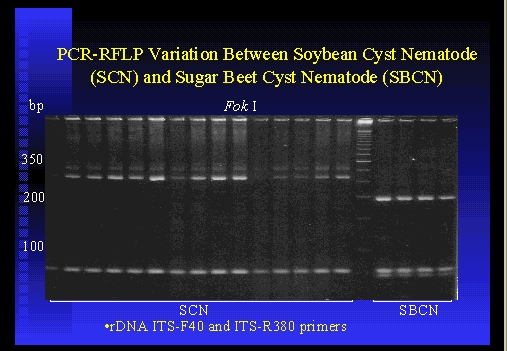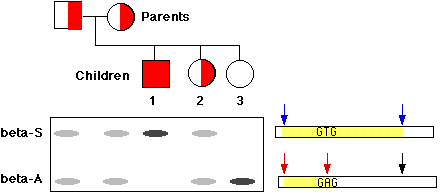Learn About RFLP Analyses
What is RFLP?
Performing a RFLP Analyses
How are RFLP Analyses Used?
What is RFLP?
RFLP (pronounced "rif-lip") stands for Restriction
Fragment Length Polymorphism. The restriction fragments mentioned in the
name are sections of a DNA sequence which have been cut by a restriction
enzyme. (Click, to learn more about restriction
enzymes and even more).
The lengths of these fragments are polymorphic because certain differences
in DNA strands such as "base substitutions, additions, deletions and
other sequence rearrangements" can change the size of the restriction
fragments by affecting the number and distribution of restriction sites
(University of Nebraska-Lincoln 1997). Therefore, researchers have developed
a method of comparing DNA samples based on this differential cleavage of
DNA by restriction enzymes.
Performing a RFLP Analyses
To perform a RFLP analysis, the DNA must first be extracted
from the sample. Because RFLPs are used on DNA samples collected from places
like crime scenes and fossil records, this can be an interesting procedure.
The DNA must then be cut with one or more restriction enzyme. Each resulting
restriction fragment library is placed into the well of an agarose gel.
The subsequent electrophoresis separates the restriction fragments by size.
The shorter fragments are able to travel more quickly down the gel than
the larger ones. Because the fragments are different lengths, each DNA
sample is spread over the gel in certain banding pattern. The final step
is to visualize the DNA. In some cases, this constitutes running the DNA
with ethidium bromide in the agarose gel and/or the buffer. This allows
the researcher to see the fragment bands because the ethidium bromide complexes
with the DNA and fluoresces under UV light. In many situations, however,
there are so many DNA fragments that the use of ethidium bromide would
result in an entire lane fluorescing, instead of a few distinct bands.
Therefore, a radioactive complementary DNA probe is developed to find and
bind to a specific DNA sequence. (For more on probing a RFLP gel, chick
here.) An
autoradiograph is then made by exposing X-ray film to the radioactive probe.
When the film is developed, the targeted DNA bans can be seen.
How is it used?
So now that you understand what a RFLP is and how to
perform an analysis, don't you what to know what can be done with this
technology? In fact, there are several scientific areas that use RFLP analyses.
Systematics, Genetics and Ecology:
Phylogenetics, the study of evolutionary relationships,
is just one field that has benefited from the advent of RFLP technologies.
By comparing the fragment patterns of different species (Fig. 1), an evolutionary
biologist can gather information about the possible relatedness of those
species.

Fig. 1. RFLP gel showing the banding differences
between two closely related species, Soybean Cyst Nematode and Sugar Beet
Cyst Nematode (University of Nebraska-Lincoln 1997).
RFLPs are not only used to compare species, but information
about intraspecific variation can also be obtained. Such comparisons can
be useful to a geneticist trying to determine the genetic make-up of a
population or to an ecologist who needs information about the genealogy
of a population (Fig 2).

Fig. 2. An RFLP Map of a Loblolly Pine Population
(Neale and Sederoff R. 1996)
Medicine:
RFLPs analyses have become very popular in the field
of medicine. Genetic counseling is founded on RFLP analyses and the ability
to determine genotypes (Fig. 3). RFLPs can be used to determine the genotype
of potential parents, and following an amniocentesis or human chorionic
fluid sampling, RFLPs are used to screen for deleterious genotypes in the
fetus. One such test is available for sickle-cell anemia (Hushey 1996).

Fig. 3. A restriction site diagram (lower right)
showing the different fragment sizes (yellow) of the dominant beta-A chain
and the recessive beta-S sequence. A pedigree diagram (upper left) depicting
the genotype of children from parents that are heterozygous for sickle-cell
anemia allele (red). In the lower left are the results of the RFLP analysis
which has two bands for the heterozygous parents and child 2, a thick band
of beta-S for the homozygous recessive, sickle-cell afflicted, child 1
and a thick band of beta-A for the homozygous dominant bands child 3 (Kimball
1997).
Forensics:
Criminal investigation also uses RFLPs as part of forensic
analysis of the crime scene. They compare RFLP patterns of DNA found on
evidence to those of the victim and suspect(s) (Fig. 4). The probability
that some DNA in the evidence comes from the suspect is related to the
number of bands in the evidence lanes that are also found in the suspect's
pattern, but cannot be accounted for in the victim's RFLP.

Fig. 4. An example of a RFLP analysis performed
for forensic purposes. Lanes 1,2,7,11 and 15 have molecular weight markers.
Evidence is in lanes 9 and 12. The victim's DNA is in lane 4 and suspects'
in 5 and 6 (Stokely 1997).
In one famous case, the results of tests similar to this
one were presented as evidence. Click here
for the results and see if you think he did it.
I hope that this brief synopsis of RFLP and its uses
have made you fall in love with RFLP. So if you really want to know more
check out these additional links on RFLP
methods and types
of RFLP Polymorphisms.
Works Cited
Hushey RJ. 1996 May. Genotype determination using RFLP's and a gene
probe. <http://wsrv.clas.virginia.edu/~rjh9u/hbsrflp.html>
Accessed 1998 17 Feb.
Johns Hopkins Medical Institute. 1994 Aug. Mapping and Sequencing the
Human Genome. <http://www.bis.med.jhmi.edu/Dan/DOE/prim2.html>
Kimball JW. 1997 May. Restriction Fragment Length Polymorphisms (RFLPs).
<http://www.ultranet.com/~jkimball/BiologyPages/R/RFLPs.html>
Accessed 1998 17 Feb.
Neale D, Sederoff R. 1996 Sept. Genome mapping in pines takes shape.
National Agricultural Library. <http://www.nalusda.gov/pgdic/Probe/v1n3_4/genome.html>
Accesssed 1998 17 Feb.
Stokely RD. 1997 May. DNA profiling in a first degree murder case: RFlP
analysis. <http://www.biology.arizona.edu/human_bio/activities/stokely/RFLP.html>
Accessed 1998 17 Feb.
University of Nebraska-Lincoln, Institute of Agriculture and Natural
Resources. 1997 Nov. Restriction Fragment Length Polymorphism (RFLP). <http://ianrwww.unl.edu/ianr/plntpath/nematode/its_id/pcr_rflp.htm>
Accessed 1998 17 Feb.
Molecular
Biology Home Page
Return
to Davidson College Biology Department Home Page
© Copyright 2000 Department of Biology,
Davidson College, Davidson, NC 28036
Send comments, questions, and suggestions to: anford@davidson.edu




